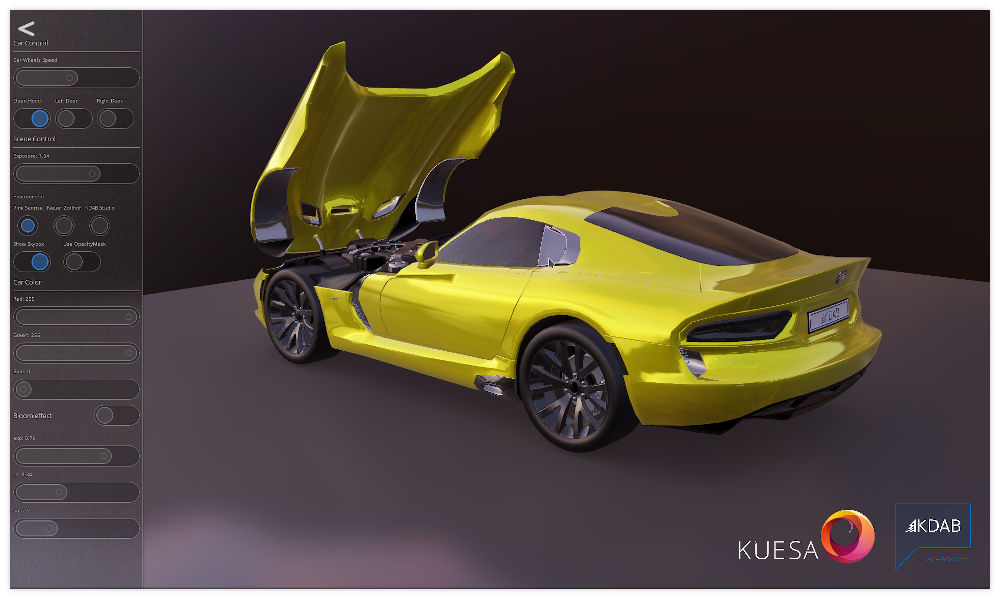Demonstrates the use of the Kuesa API to import a glTF2 file and extract assets from it.

The car-scene example relies on the regular QtQuick and Qt 3D APIs to instantiate a QtQuick based application that combines Qt 3D based content with a 2D UI overlay.
Item { id: mainRoot // 3D Content Material.theme: Material.Dark Material.accent: Material.Blue Item { id: baseUI anchors.fill: parent Wind { id: wind anchors.fill: parent visible: menu.useOpacityMask } Scene3D { id: scene3D anchors.fill: parent focus: true multisample: true aspects: ["input", "animation", "logic"] // Root Scene Entity MainScene { id: sceneContent ...
Kuesa provides the SceneEntity element which holds collections of Qt 3D assets accessible by name.
import Kuesa 1.2 as Kuesa import Kuesa.Effects 1.2 as Effects Kuesa.SceneEntity { id: scene
In order to load a glTF2 file, Kuesa provides the GLTF2Importer element. If the sceneEntity property is set to a valid SceneEntity instance, Qt 3D assets generated while parsing the file will be automatically added to the various asset collections.
// Loads GLTF 2.0 asset
Kuesa.GLTF2Importer {
sceneEntity: scene
source: "qrc:/DodgeViper" + _modelSuffix + ".gltf"
}
Usually, you will want to interact with some elements of your scene. The Asset element allows to retrieve an asset by name. If the asset for a given name really exist in the specified collection, the node property allows you to access the underlying asset instance.
You can use the Kuesa Studio gltfInspector to introspect a glTF2 scene files and find the names of the various assets it contains.
For instance you might want to select a Camera by name.
Kuesa.Asset {
id: sweepCam
collection: scene.cameras
name: "SweepCam"
}
Once retrieved, you can create binding on some of the Camera properties.
QQ2.Binding {
target: sweepCam.node
property: "aspectRatio"
value: mainCamera.aspectRatio
}
Similarly you could retrieve a Material asset
// We create a baseColorFactor property. If the property exists in the node, it will be a proxy of the node property
// When we set the qml property, the node property will be updated accordingly
// When the node property is updated in C++, the qml property will be updated
// As soon as the node is changed, the qml property is updated if it has a C++ equivalent
Kuesa.Asset {
property color baseColorFactor: scene.carBaseColorFactor
id: carMaterial
collection: scene.materials
name: "Mat_CarPaint"
onBaseColorFactorChanged: console.log("Binding 1 works. Color: " + baseColorFactor)
onNodeChanged: scene.carBaseColorFactor = carMaterial.baseColorFactor
}
And create a binding on its properties to control the appearance of elements in the scene that use that material.
property var baseColorFactorProp: carMaterial.baseColorFactor
onBaseColorFactorPropChanged: console.log("Binding 2 works. Color: " + baseColorFactorProp)
The AnimationPlayer allows to control the playback of animation clips that can be retrieve by name.
Kuesa.AnimationPlayer {
id: hoodAnimator
sceneEntity: scene
clock: Clock { }
clip: "HoodAction"
}
Kuesa.AnimationPlayer {
id: leftDoorAnimator
sceneEntity: scene
clock: Clock { }
clip: "DoorLAction"
}
Kuesa.AnimationPlayer {
id: rightDoorAnimator
sceneEntity: scene
clock: Clock { }
clip: "DoorRAction"
}
First you need to instantiate the effects you want to use.
Effects.OpacityMask {
id: opacityMaskEffect
mask: TextureLoader {
source: "qrc:/opacity_mask.png";
generateMipMaps: false
}
premultipliedAlpha: true // This is what Scene3D/QtQuick expects
}
Effects.BloomEffect {
id: bloomFx
threshold: 0.34
blurPassCount: 2
}
Once you have created the effects, they need to be added to the ForwardRenderer FrameGraph. The order in which they are added dictates the order in which they are applied.
RenderSettings {
// FrameGraph
activeFrameGraph: Kuesa.ForwardRenderer {
id: frameGraph
camera: scene.animated && sweepCam.node ? sweepCam.node : mainCamera
postProcessingEffects: {
var effects = []
if (useBloomEffect)
effects.push(bloomFx)
if (useOpacityMask)
effects.push(opacityMaskEffect)
return effects
}
skinning: showSkybox
backToFrontSorting: true
toneMappingAlgorithm: Effects.ToneMappingAndGammaCorrectionEffect.Reinhard
// showDebugOverlay: true
}
},
Files:
Images: